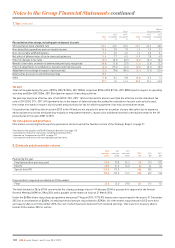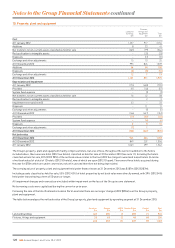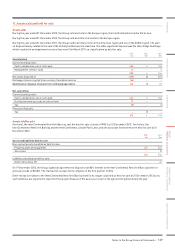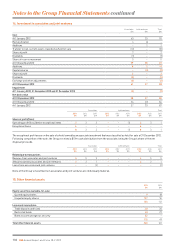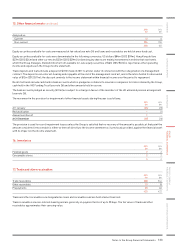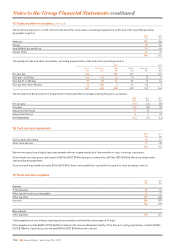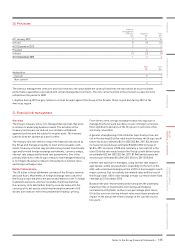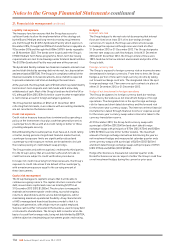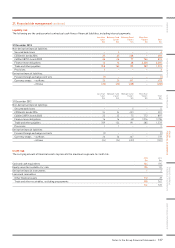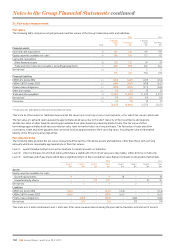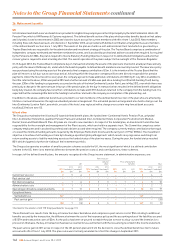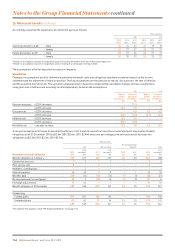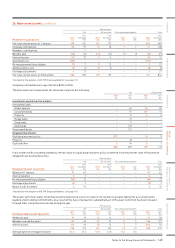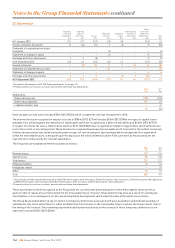Holiday Inn 2013 Annual Report Download - page 138
Download and view the complete annual report
Please find page 138 of the 2013 Holiday Inn annual report below. You can navigate through the pages in the report by either clicking on the pages listed below, or by using the keyword search tool below to find specific information within the annual report.
Liquidity risk exposure
The treasury function ensures that the Group has access to
sufficient funds to allow the implementation of the strategy set
by the Board. Medium and long-term borrowing requirements
are met through the $1.07bn Syndicated Facility which expires in
November 2016, through the £250m 6% bonds that are repayable on
9December 2016 and through the £400m 3.875% bonds repayable
on 28 November 2022. The bonds were issued under the Group’s
£750m Medium Term Notes programme. Short-term borrowing
requirements are met from drawings under bilateral bank facilities.
The $1.07bn Syndicated Facility was undrawn at the year end.
The Syndicated Facility contains two financial covenants: interest cover
and net debt divided by earnings before interest, tax, depreciation
and amortisation (EBITDA). The Group is in compliance with all of the
financial covenants in its loan documents, none of which is expected
to present a material restriction on funding in the near future.
At the year end, the Group had cash of $134m which is predominantly
held in short-term deposits and cash funds which allow daily
withdrawals of cash. Most of the Group’s funds are held in the UK or
US, although $12m (2012 $7m) is held in countries where repatriation
is restricted as a result of foreign exchange regulations.
The Group had net liabilities of $74m at 31 December 2013
reflecting that its brands, in accordance with accounting standards,
are not recorded on the balance sheet.
Credit risk exposure
Credit risk on treasury transactions is minimised by operating a
policy on the investment of surplus cash that generally restricts
counterparties to those with an A credit rating or better or those
providing adequate security.
Notwithstanding that counterparties must have an A credit rating
orbetter, during periods of significant financial market turmoil,
counterparty exposure limits are significantly reduced and
counterparty credit exposure reviews are broadened to include
therelative placing of credit default swap pricings.
The Group trades only with recognised, creditworthy third parties.
Itis the Group’s policy that all customers who wish to trade on
credit terms are subject to credit verification procedures.
In respect of credit risk arising from financial assets, the Group’s
exposure to credit risk arises from default of the counterparty,
witha maximum exposure equal to the carrying amount of
theseinstruments.
Capital risk management
The Group manages its capital to ensure that it will be able to
continue as a going concern. The capital structure consists of net
debt, issued share capital and reserves totalling $1,071m at
31December 2013 (2012 $1,382m). The structure is managed to
maintain an investment grade credit rating, to provide ongoing
returns to shareholders and to service debt obligations, whilst
maintaining maximum operational flexibility. A key characteristic
ofIHG’s managed and franchised business model is that it is
highlycash generative, with a high return on capital employed.
Surplus cash is either reinvested in the business, used to repay debt
or returned to shareholders. The Group’s debt is monitored on the
basis of a cash flow leverage ratio, being net debt divided by EBITDA,
with the objective of maintaining an investment grade credit rating.
Hedging
Interest rate risk
The Group hedges its interest rate risk by ensuring that interest
flows are fixed on at least 25% of its borrowings inmajor
currencies. If required, the Group uses interest rate swaps
to manage the exposure although none were held at either
31 December 2013 or 31 December 2012. The Group designates
interest rate swaps as cash flow hedges. At both 31 December
2013 and 31 December 2012, the Group’s interest flows were
100% fixed due to the low interest environment and profile of the
Group’s debt.
Foreign currency risk
The Group is exposed to foreign currency risk on income streams
denominated in foreign currencies. From time to time, the Group
hedges a portion of forecast foreign currency income by taking
out forward exchange contracts. The designated risk is the spot
foreign exchange risk. There were no such contracts in place at
either 31December 2013 or 31 December 2012.
Hedge of net investment in foreign operations
The Group designates its foreign currency bank borrowings
and currencyderivatives as net investment hedges of foreign
operations. Thedesignated risk is the spot foreign exchange
risk for loans and shortdated derivatives and the forward risk
for the seven-year currency swaps. The interest on these financial
instruments is taken through financial income or expense except
for the seven-year currency swaps where interest is taken to the
currency translation reserve.
At 31 December 2013, the Group held currency swaps with
a principal of $415m (2012 $415m) and short dated foreign
exchange swaps with principals of €75m (2012 €75m) and $100m
(2012 $170m) (see note 23 for further details). The maximum
amount of foreign exchange derivatives held during the year as
net investment hedges and measured at calendar quarter ends
were currency swaps with a principal of $415m (2012 $415m)
and short dated foreign exchange swaps with principals of €75m
(2012 €75m) and $310m (2012 $350m).
Hedge effectiveness is measured at calendar quarter ends.
Noineffectiveness arose in respect of either the Group’s cash flow
ornet investment hedges during the current or prior year.
21. Financial risk management continued
136 IHG Annual Report and Form 20-F 2013
Notes to the Group Financial Statements continued


